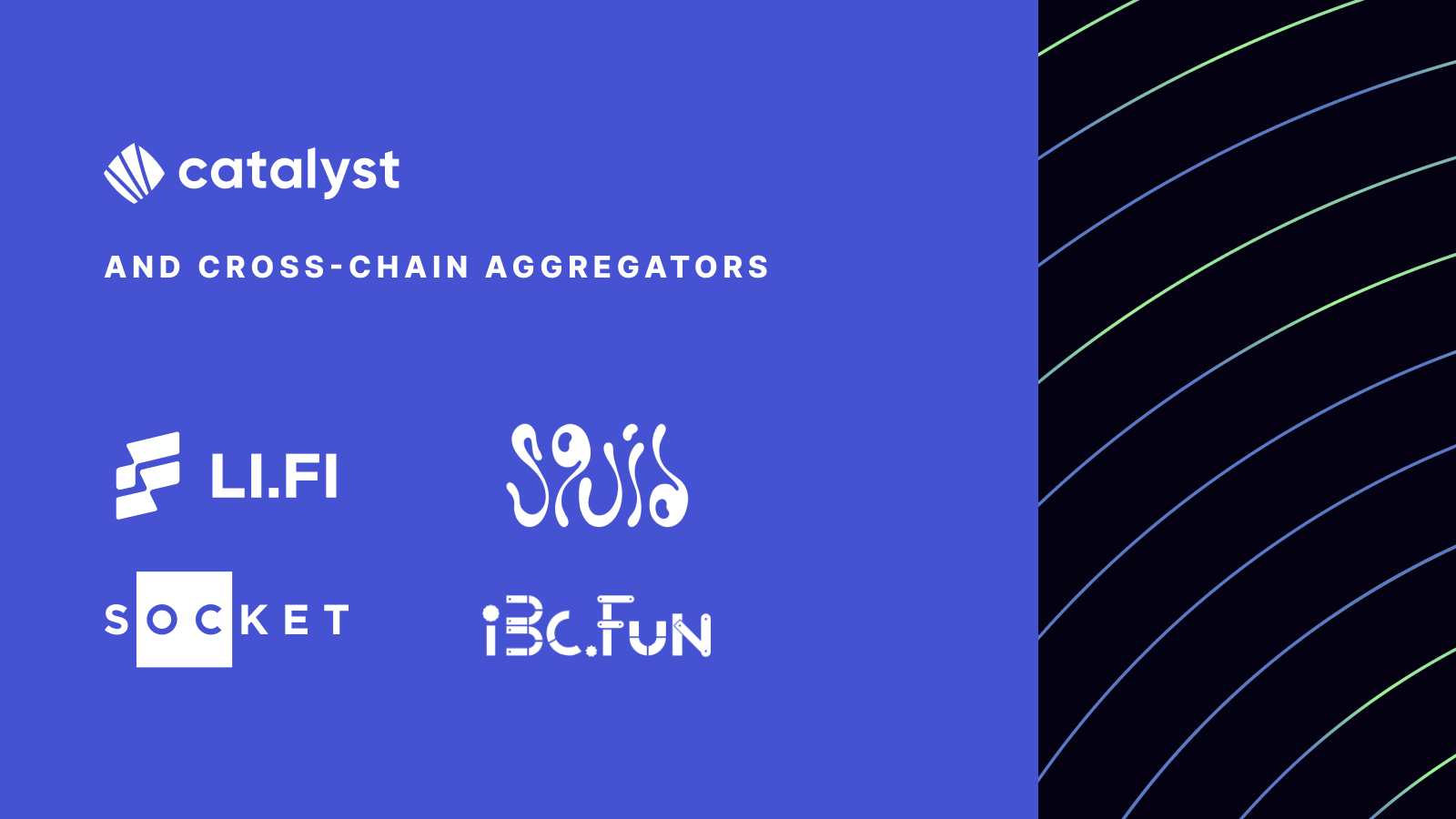Catalyst and Cross-Chain Aggregators

In the vast and evolving landscape of cross-chain, all cross-chain projects are working towards the same end goal: allow individuals to access cross-chain state in the easiest manner possible.
Said differently, individuals (and entities) have “intents” that span multiple domains, and they need infrastructure in order to allow them to accomplish those intents through an easy-to-understand interface.
Delivering a seamless cross-chain experience means that complexity needs to be abstracted away, enabling users to interact with cross-chain functionality without getting bogged down by the intricacies under the hood. This user-centric approach transforms the cross-chain landscape, making it accessible to a wider audience, regardless of their technical abilities.
Consider the common cross-domain intent: "swapping Asset X on Chain A for Asset Y on Chain B." In the past, realizing this intent would involve a series of manual steps for the individual to complete, each on a different user interface:
- Swap Asset X for an intermediary Asset on Chain A through one UI.
- Bridge the intermediary asset from Chain A to Chain B using another UI.
- Optionally, obtain gas tokens for Chain B to facilitate transactions.
- Swap the intermediary asset for Asset Y on Chain B through yet another UI.
Each step required navigating different interfaces, managing assets, and potentially even dealing with gas tokens. This complexity created barriers for individuals seeking to achieve their cross-domain intents.
Read more about the pains of current cross-chain UX in Uma’s talk on Research Day in New York.
Cross-chain Routers: A Primer
Imagine a platform where an individual can input their intent - to swap Asset X for Asset Y across chains - and the platform orchestrates the multiple steps required behind the scenes. Users are shielded from the intricacies of asset swapping, intermediary tokens, and gas tokens. Instead, they experience a streamlined interface that seamlessly bridges their intent and the underlying infrastructure.
Several projects have emerged in recent years that seek to optimally route and bundle transactions on behalf of the individual:
These projects, also known as cross-chain aggregators, represent a subset of a larger category called Aggregators, which also includes popular DEX aggregators like 1inch, 0x, and Paraswap.
Much like their counterparts in the DEX aggregator space, cross-chain routers find the most optimal route for users' transactions, ensuring that their intents are executed efficiently and effectively.
To illustrate, let’s revisit the cross-domain intent of “swapping Asset X on Chain A for Asset Y on Chain B”. Instead of requiring users to manually perform multiple steps across different interfaces, cross-chain routers streamline the process. These routers bundle all the necessary transactions, including swapping, bridging, and more, into a single signature. This signature is the key that unlocks a 1-click experience, seamlessly aligning users' intent with execution.
By optimizing transaction routing and bundling, cross-chain routers simplify complex multi-step transactions, offering users a seamless, user-friendly experience that reduces friction and enhances accessibility.
In addition, cross-chain routers can identify routes that provide the best price execution for a given swap pair. By analyzing prices across various bridges and exchanges, cross-chain routers ensure that users receive optimal value for their transactions. Additionally, they prioritize speed, seeking routes that guarantee the fastest execution time. This dual focus on price and speed optimization underscores the commitment of cross-chain routers to elevate the user experience.
Catalyst: Liquidity for Cross-Chain Intents
At Catalyst, we have the same end goal as that of cross-chain routers–we want to service individuals and provide them the best possible cross-chain user experience. The vision for Catalyst is to allow individuals to access any asset or any application (through logic-dependent swaps) from any chain.
With logic-dependent swaps, users can execute transactions that are not solely asset-centric but also encompass a broader logic, opening doors to a new realm of cross-chain possibilities.
For now, the Catalyst UI is focused on cross-chain swaps, mirroring the user experience that cross-chain routers deliver. As the space evolves, so does the UI. Over time, the Catalyst UI will allow for full user expressivity of their cross-chain intents–allowing users to articulate their intentions across domains in a manner that reflects their unique needs and aspirations.
With that said, Catalyst UI is merely a reference implementation that showcases the power of the Catalyst Protocol. We invite all frontends–such as wallets–and cross-chain routers to tap into the cross-chain liquidity of Catalyst Protocol.
Through that lens, Catalyst is not competitive with cross-chain routers. Instead, Catalyst leverages cross-chain routers for additional distribution to their respective user bases. Catalyst embraces cross-chain routers as collaborative partners, not competitors.
For cross-chain routers, Catalyst gives them two benefits:
- Competitive routes for cross-chain swaps
- Quick access to new chains and L2s
On existing chains such as Ethereum and its major L2s, Catalyst can offer competitive routes for cross-chain routers to service to its user base. That’s because Catalyst can offer a 1-leg swap instead of the multi-legged swap that needs to be done by current liquidity venues.
Let’s revisit the “swapping Asset X on Chain A for Asset Y on Chain B” example. With cross-chain routers, the individual no longer needs to perform 3-5 transactions in order to receive Asset Y on Chain B. However, the cross-chain router is still performing those 3-5 transactions–and merely abstracting away that complexity from the individual.
Here's where Catalyst steps in. By minimizing the swap to a single leg, Catalyst transforms the landscape for cross-chain routers. The router's role shifts from managing multiple transactions to orchestrating a single transaction, substantially streamlining the process.
With Catalyst, the cross-chain router only has to perform one transaction underneath the hood. To learn more about how that precisely works, read more about the Unit of Liquidity and a Catalyst transaction flow.
With Catalyst's streamlined approach, cross-chain routers gain a significant advantage. Catalyst's single-leg swap translates to 50-80% less slippage, increased gas savings, and fundamentally quicker execution.
Catalyst's protocol design offers another valuable benefit to cross-chain routers - the ability to seamlessly and permissionlessly integrate with new chains and rollups as they go live. That means that a new app-specific rollup can automatically swap assets with any chain of its desire right out of the box.
This instantaneous connectivity to new chains and rollups gives cross-chain routers who integrate Catalyst a strategic advantage–allowing them to rapidly extend their services to new chains and bolster their value proposition to users.
The relationship between Catalyst and cross-chain routers is a harmonious dance of collaboration and empowerment. Catalyst, far from being a competitor, assumes the role of an enabler, enhancing the capabilities and reach of cross-chain routers. Through competitive routes, streamlined processes, efficiency enhancements, and rapid access to new chains, Catalyst bestows a host of advantages upon cross-chain routers, strengthening their position and enriching the user experience.
About Cata Labs
Cata Labs is a software development company that contributes to open-source technology, including Catalyst Protocol. Cata Labs is backed by prominent investors such as Spartan Group, HashKey, Polygon and Circle. Check out our website here and read more here.
Catalyst Protocol is an AMM purpose-built to connect all chains. Its mission is to empower individuals to acquire any asset on any chain. Using Catalyst, any chain can swap assets with major blockchains like Cosmos, Ethereum and its rollups. Catalyst Protocol is operated by Catalyst Foundation, based in the Cayman Islands. Find out more about Catalyst Foundation at its website. Contact Catalyst Foundation here.

